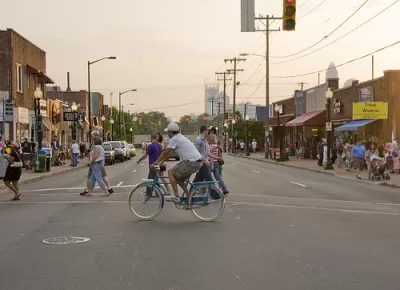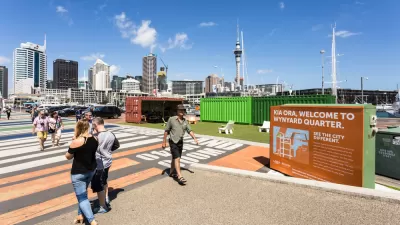Meghan Gough, assistant professor at the Virginia Commonwealth University, guest blogs about her work on balancing livability and sustainability.

Communities cannot be sustainable unless they are places where people want to live. But can communities be both livable and sustainable? If so, how does this translate to planners and policymakers, working on the frontier of livability and sustainability practice? I tackle these issues in my new research published in the Journal of Planning Education and Research.
Discussion about the conflicts between livability and sustainability was introduced more than a decade ago when Godschalk (2004) modified Campbell's (1996) conceptual triangle of conflicts by adding a livability dimension. Yet the linkages between livability and its counterpart sustainability are not fully understood, limiting agreement on the policies to promote these ideals. Now we see there is an important nexus between the two concepts that may assist in the other’s success. Livability interventions serve as incremental steps that collectively increase the potential for long-term sustainability.

The acknowledgement that public values and perceptions of livability can trump their long-term sustainability concerns, can inform the design of livable cities that are also sustainable. Consumers should have a right to both "livable" and "sustainable" communities, but what do these concepts mean?
It is easiest to understand livability when placed in comparison to sustainability. When we talk about sustainability, most research embraces the notion of balancing the long-term interests of economics, environment, and equity while also recognizing the demands of current and future generations. In practice, however, implementation largely favors one principle over the other two, often with social equity prioritized less. The result: sustainability as an attractive vision, but on its own largely failing to move to adopted practices (see Table 1).

By contrast, livability is about the "here" and "now," focusing on interventions that can have immediate influence on the needs of the locality. The experience of place—where people live, how they travel to work, and ways that they interact with each other and their surroundings—makes them more "livable."

My research with communities on the Gulf Coast shows that the complementarities of livability and sustainability constitute an important viewpoint for land use planning. Furthermore, we can distill three reasons why livability can be used as a vehicle for sustainability: 1) scale, 2) context, and 3) potential to enable change.
Reason 1: Scale
Planners find challenges inherent in the formidable scale of sustainability both in terms of its definition and its audience. The concept of livability grew out of a view that environmental, economic, and equity issues must be considered at a narrower spatial scale relevant to individual people, neighborhoods, and communities in geographically smaller areas. While competing publics can use the political or public debate process to influence the definition and beneficiaries of livability investments, the broader and long-term scale of sustainability limits the tangible power of stakeholders.

Reason 2: Context
Livability responds to the values of stakeholders and how each adapts to changing conditions or preferences, bringing relevance for stakeholders and decision makers to abstract sustainability visions. While sustainability assumes an unchanging vision that joins economic, environmental, and equity values, livability is dynamic and evolves in response to shifting conditions and values. As a result, livability offers a way to translate sustainability into a context that relates more closely to interventions: livability represents the messy and changing domain through which sustainability is implemented.
Reason 3: Potential
A final reason for recognizing linkages between livability and sustainability is the "potential" livability brings to enable change through interventions. The formidable vision of long-term sustainability must be broken down into pragmatic, incremental strategies for livability. The strong local component of livability emerges in practical terms when potential to enable change with policy and planning interventions. Because livability is broken down into measurements of success based on the local political reality, the implementation of livability preferences—such as walkable neighborhoods or safe public spaces—are within the purview of local agencies and planners. The result: higher potential for change.

Understanding how livability relates to sustainability will help planners bridge the desires of residents in the present moment with longer-term needs associated with a sustainability vision. Sustainable outcomes become more tangible over time through a series of livability outcomes.
Guest Blogger: Meghan Z. Gough, Ph.D., Assistant Professor, Wilder School of Government and Public Affairs, Virginia Commonwealth University
Enjoy free access to this article until May 30, 2015, via SAGE Publications:
Follow JPER on Twitter @JPER7 or Facebook https://www.facebook.com/JPERPlanning.

Trump Administration Could Effectively End Housing Voucher Program
Federal officials are eyeing major cuts to the Section 8 program that helps millions of low-income households pay rent.

Planetizen Federal Action Tracker
A weekly monitor of how Trump’s orders and actions are impacting planners and planning in America.

Ken Jennings Launches Transit Web Series
The Jeopardy champ wants you to ride public transit.

Rebuilding Smarter: How LA County Is Guiding Fire-Ravaged Communities Toward Resilience
Los Angeles County is leading a coordinated effort to help fire-impacted communities rebuild with resilience by providing recovery resources, promoting fire-wise design, and aligning reconstruction with broader sustainability and climate goals.

When Borders Blur: Regional Collaboration in Action
As regional challenges outgrow city boundaries, “When Borders Blur” explores how cross-jurisdictional collaboration can drive smarter, more resilient urban planning, sharing real-world lessons from thriving partnerships across North America.

Philadelphia Is Expanding its Network of Roundabouts
Roundabouts are widely shown to decrease traffic speed, reduce congestion, and improve efficiency.
Urban Design for Planners 1: Software Tools
This six-course series explores essential urban design concepts using open source software and equips planners with the tools they need to participate fully in the urban design process.
Planning for Universal Design
Learn the tools for implementing Universal Design in planning regulations.
Ada County Highway District
Clanton & Associates, Inc.
Jessamine County Fiscal Court
Institute for Housing and Urban Development Studies (IHS)
City of Grandview
Harvard GSD Executive Education
Toledo-Lucas County Plan Commissions
Salt Lake City
NYU Wagner Graduate School of Public Service




























